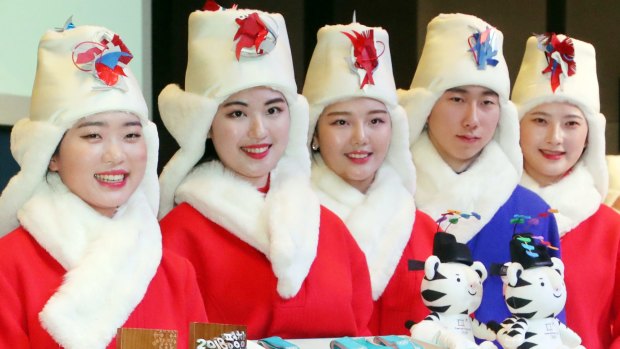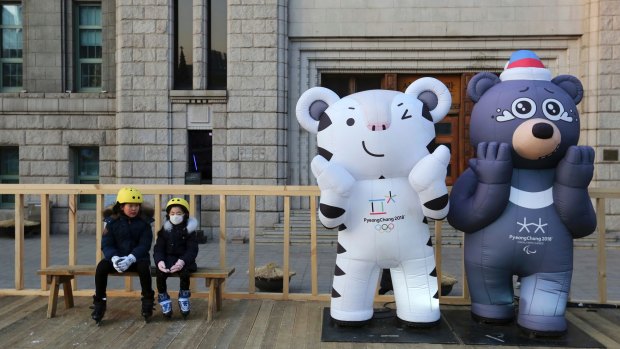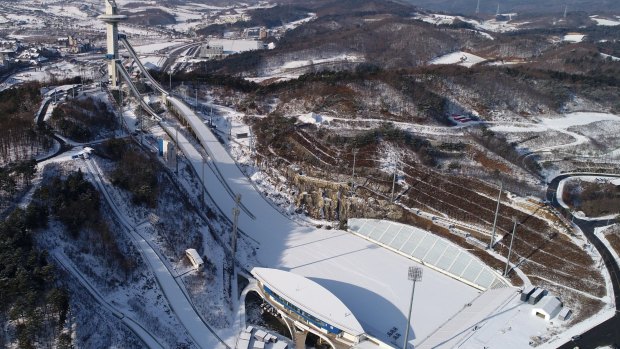This was published 6 years ago
Gangwon: The South Korean province hosting the 2018 Winter Olympics
The South Korean province of Gangwon is gearing up for a wave of foreign arrivals during the Winter Olympic Games this February.
By Mark Daffey

The uniforms to be worn in the victory ceremonies for 2018 Pyeongchang Olympic and Paralympic Winter Games. South Korea's Pyeongchang is the host city of the 2018 Olympic and Paralympic Winter Games in February. Credit: Choi Jae-gu/Yonhap via AP
Every summer, thousands upon thousands of Koreans flock to Gangneung for beaches that the local mayor describes as "better than Waikiki", and for its raw fish restaurants. Even in winter, on New Year's Eve, cars jam the expressways out of Seoul so people can watch the sun rise over the sea. And there's no better place to watch it than from the terraces of a cafe along Gangneung's Anmok Coffee Street.
Come to Gangneung this February though and it's likely the Winter Olympic Games will be the main drawcard. Venues for the PyeongChang Games, which take place from February 9-25, with the Paralympic Games being staged a month later, have been divided into two clusters just 40 minutes apart, all within Gangwon Province.
The PyeongChang Mountain Cluster, which includes Alpensia Sports Park, Yongpyong Alpine Centre, Bokwang Snow Park and Jeongseon Alpine Centre, will host the snow and sliding sports events. Ice sports – long and short track speed skating, ice hockey, figure skating and curling – will be staged in the Gangneung Coastal Cluster.

Children sit next to the 2018 Pyeongchang Winter Olympic Games' official mascots, a white tiger Soohorang, for the Olympics, Credit: AP
Because of the Koreans' love of short track and figure skating, ticket sales to date indicate that more locals will attend the Games in Gangneung. Post-Olympic crowds are more likely to head for the Taebaek Mountain range, shadowing the Korean Peninsula's east coast. It's here, in Gangwon's PyeongChang County, where the remainder of the Olympic events will take place, and where the skiing and snowboarding attracts winter sports enthusiasts from all over, in particular from Asian countries.
The Jeongseon Alpine Centre will stage the blue riband Downhill event, as well as the Super-G and Alpine Combined, on a specially made course. Close by is High1 Resort. Despite its name, High1 is not South Korea's highest alpine resort – at 1458 metres, that honour goes to Yongpyong – though it is still home to some of the best winter skiing and snowboarding in the country. The 18-hole, par 72 public golf course is a summer favourite due to its pleasant climate and scenic alpine setting. And the on-site casino is the only one open to Koreans and foreigners alike.
Jeongseon was formerly South Korea's coal mining centre, but it is fast turning into an adventure playground for hikers, cyclists and white-water rafters. History buffs can stop at the Arirang School Remembrance Museum for a nostalgic look into South Korea's recent past. And those with a head for heights should visit the Byeongbangchi Skywalk, a glass-bottomed observatory platform high above a crook in the Donggang River.

The Alpensia Ski Jumping Center, the venue for the ski jump competition at the 2018 Pyeong Chang Winter Olympics, east of Seoul. Credit: Alamy
Each of the Olympic venues will be accessible by high-speed KTX Fast Trains, which opened just in time for the Games in December 2017. Travelling at speeds exceeding 300km/h, Gangneung is less than three hours from Incheon International Airport and under two hours from the capital, Seoul. Those travelling to Jeongseon will alight at Jinbu Station (1hr 45mins) then take a shuttle bus to Jeongseon Alpine Centre.
The remaining venues are clustered around the Olympic Stadium in Daegwalnyeong-myeon, where 35,000 spectators are expected to witness the opening and closing ceremonies in the shadow of Mt Balwang – home to South Korea's premier winter sports resort, Yongpyong. Established in 1975 as the first skiing facility in Korea, its Dragon Peak summit is where the medals will be decided for the slalom and giant slalom events.
The 620-acre Alpensia Sports Park nearby includes the Sliding Centre, which will host bobsleigh, luge and skeleton events on a 2018-metre long track – one of just 16 in the world. Biathlon, cross-country and ski jumping events will be staged across the opposite side of the valley.
Further west, Bokwang Snow Park is the closest decent-sized winter resort to Seoul and it has captured a market niche as the preferred venue for the snowboarder-dominated younger generation since its opening in 1995. Twenty-two ski slopes cascade down Taegi Mountain, where freestyle skiing and snowboard events will be battled out.
PyeongChang's foremost tourist attraction is the seventh-century Buddhist temple of Woljeongsa. The temple is set among one of the most naturally beautiful settings in South Korea, inside the Odaesan National Park. A delightful kilometre-long pathway from the temple's Iljumun Gate passes through magnificent fir forest before arriving at the nerve centre for the Jogye Order of Korean Buddhism.
Inside the complex is a nine-storey pagoda, a museum displaying artefacts and treasures from the Buddhist culture of the Goryeo Dynasty that ruled from AD 918-1392, and a seated Buddha made from stone. There's also a flourishing templestay program. And, of course, it contains a cosy, glass-roofed cafe for taking in the natural surroundings while cradling a hot latte.
There are reasons other than the Olympics to visit the area and cities like Gangneung, though. Gyeongpo Lake is separated from the sea by a narrow sand spit, and in the middle of the lake is a pavilion from which it is said you can see the moon five times – once in the sky, once in the sea, once in the lake, once in the drink in your hand and once in the eye of your lover.
South of the city, Haslla Art World is an 11-hectare sculpture park that's likely to exceed expectations because of its impressive garden setting, high on a hillside overlooking the sea. Artworks include an installation made from cow dung and enormous mid-air stones suspended by cables, and the adjacent Haslla Museum Hotel is one of the quirkier hotels you're likely to stay in.
All 24 rooms have beds resembling a mother's womb and there's a complete absence of mirrors – a deliberate oversight that is intended to divert attention from oneself and into the inviting world of art. It also has five art galleries, with a special exhibition room dedicated to Pinocchio.
TRIP NOTES
MORE
FLY
Korean Air flies daily from Sydney to Seoul/Incheon, and offers direct flights from Brisbane four times a week, with daily flights during the peak season of December to February. See koreanair.com
TOUR
KTX's (letskorail.com/pyeongchang) Gyeonggang Line services the Olympic hubs of PyeongChang, Jinbu and Gangneung from Incheon International Airport or Seoul.
STAY
The InterContinental Alpensia Pyeongchang Resort is on the doorstep of Alpensia Resort, just 10 minutes from Yongpyong and a 30-minute drive from Bokwang Phoenix Park (see ihg.com). Rooms in Gangneung's Haslla Art World Museum Hotel cost about $250 a night (see haslla.kr).
Mark Daffey visited South Korea courtesy of the Korean Tourism Organisation
FIVE OF THE BEST NON-OLYMPIC SIGHTS
CITY PALACES
Changdeokgung is the prettiest of Seoul's five World Heritage-listed city palaces, all built by Joseon Dynasty rulers. Watch the Changing of the Guard at Deoksugung Palace.
N SEOUL TOWER
Seoul's landmark attraction atop Namsan Mountain offers sweeping 360-degree views over South Korea's largest city from its observation deck.
DEMILITARISED ZONE (DMZ)
The world's most heavily fortified border region is part-museum, part-theme park, but there's no denying the barbed wire or the grim skirmishes that have occurred here.
HWASEONG FORTRESS
Walk along the 5.7-kilometre ramparts of this 18th-century citadel in Suwon, the power centre for King Jeongio's Joseon Dynasty.
JEJU ISLAND
Climb Seongsan Sunrise Peak on Jeju Island to watch the sunrise. The 30-minute hike up this 180-metre-high volcanic crater is best done up the northwest ridge.
Sign up for the Traveller Deals newsletter
Get exclusive travel deals delivered straight to your inbox. Sign up now.